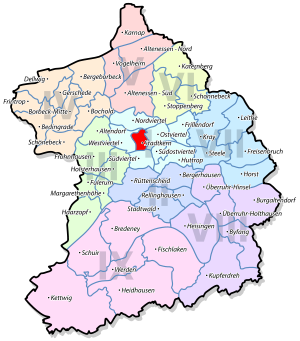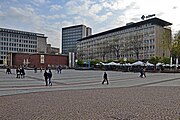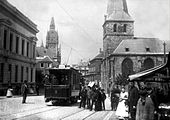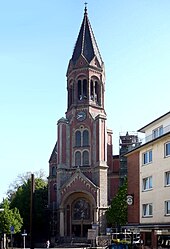City center (Essen)
|
City center |
|

|
|
| Basic data | |
|---|---|
| surface | 0.94 km² |
| Residents | 4052 (March 31, 2020) |
| Coordinates | 51 ° 27 '30 " N , 7 ° 0' 47" E |
| height | 68 m |
| Start-up | 852 |
| Spatial assignment | |
| Post Code | 45127 |
| District number | 01 |
| district | District I city center / Frillendorf / Huttrop |
| image | |
|
Entrance to the city center from the main station from |
|
| Source: City of Essen statistics | |
The city center , together with the west , north , south , east and south- east quarters, forms the Essen city center. The city center is the smallest district in terms of area in Essen.
Downtown character and history

The nucleus of the city is the Essen Minster on Kettwiger Strasse , on Burgplatz . The house of God was the church of the women's monastery in Essen , founded around 845 by Altfrid , Bishop of Hildesheim . The Essen city walls encircled about 1244 to 1865 almost exactly the area that is now part of the city center .
In the 19th century, at the time of industrialization, the expansion of the Krupp cast steel factory to the west of what was then Essen and the surrounding coal mine attracted more and more immigrants as workers. House numbering according to street names was officially introduced in the city center for the first time in 1861. At the beginning of the 19th century it was sufficient to number the houses individually.
Essen describes itself as the shopping city - a name that was coined in 1938 by the advertising community at the time, but only dominated as a topic after the Second World War . Up until then, until it was over 90 percent destroyed in the war, the city center was mainly residential. From 1944 to March 1945 there was a subcamp of Buchenwald concentration camp in the city center , the Schwarze Poth subcamp , for which a memorial was set up in 2002 in the former staircase to the Porsche pulpit.
As the most important shopping city in the Ruhr area, Essen should now drive the reconstruction. In 1960 retail sales had doubled compared to 1950. The retail sector overtook the mining industry, which had previously been the leading industry. In 1964, 23 percent of the gross national product was generated in retail, which was significantly higher than the value of its competitors Dortmund and Duisburg . This part of the gross national product fell back below 16 percent in the 1980s, but the lettering of the same name has been seen in large letters on the roof of the Hotel Handelshof since 1951 until today . Today there are several pedestrian zones with department stores and retail stores in the city center: Kettwiger Strasse - opened on June 16, 1965, Limbecker Strasse, Rathenaustrasse and Viehofer Strasse. At the northern end of Viehofer Straße, which has been transformed into a pedestrian zone, is Viehofer Platz, which can still be recognized by the Friedrich-Ebert-Straße, which has been widened here, with the junction with the Schützenbahn. Directly on Viehofer Platz is the three-aisled St. Gertrud Church , which was completed in 1877 according to plans by August Rincklake and was rebuilt after severe war damage in 1955. Historically, the Viehofer Platz refers to the cattle farm that was formerly located here, which, as the Fronhof of the Essen women's monastery, supplied it with meat and dairy products. The cattle farm probably already existed at the time the monastery was founded. The Viehofer Tor, the northern of the four Essen city gates, was also located here until the beginning of the 19th century. To the west of Viehofer Platz is the Rheinischer Platz underground station. At the end of the 19th century, a train station for the Rheinische Eisenbahn-Gesellschaft was built here , which fell victim to the Second World War.
The central Kennedyplatz , which was called Gildenplatz from around 1953 to 1964, now connects the pedestrian zones after being redesigned in 1989, with an underground car park below it. Kennedyplatz was built on before the Second World War, so it has not grown in terms of urban history. Essen's America House has been standing on the southern part of the square since 1952 . Very close by, on II. Hagen 7, after the Evangelical Paulus Church destroyed in World War II, the house of the church of the Evangelical City Church Association was located since 1968 . In 2008/2009 this was converted into the so-called Kennedy Tower, an office and commercial building. Other buildings around Kennedyplatz include the Heroldhaus (1955, architect: Emil Jung , hotel since February 2012), the Allbauhaus (1956, architect: Willy Maximilian Schneider), the Gildenhaus (1955, architects: Wilhelm and Hans Eggeling), the C&A department store (1980), from which C&A moved in early 2010. Next to it, between Kennedyplatz and the church of St. Johann Baptist in front of the Essen Cathedral , is the Kardinal-Hengsbach-Platz, called Kurienplatz until 1994, on which the Monument to the Watching Chicken is located. The northerly commercial building on Markt 1 (1987) stands on the site of the first three Essen town halls . To the north of Kennedyplatz is Kopstadtplatz, which was laid out in 1858 . Among other things, this was the property of the Kopstadt family, who provided three Essen mayors from 1734 to 1833 . The square initially served as a market and later as a fairground. In 1896, after the Heilig-Geist-Hospital was demolished, the square was expanded. On January 19, 1899, the Varieté Wolff's Colosseum (director: Martha Wolff), a large German revue and operetta theater with around 3,000 seats and up to 400 performances per year , opened on the site of today's Kopstadt-Passage . The architects of the ornate building were Oskar and Bruno Kunhenn. In the 1930s, the simple Varieté Scala with around 1,200 seats was built here. In 1991 Kopstadtplatz was redesigned.
At the north-western end of the city center is Berliner Platz, which was named after the Wall was built in solidarity with the Berliners concerned and retained its name after the Wall fell . The almost three-meter-high sculpture of the Berlin bear made of Anröchter dolomite by the sculptor Herbert Lungwitz , which has stood in Grugapark since 1959 , was erected on July 10, 1964 at what is now known as Berliner Platz. The words Think of Berlin are embossed in its stone base . For the inauguration of Berliner Platz in July 1964, the then Governing Mayor of Berlin Willy Brandt was expected, but he was represented by his future successor Heinrich Albertz due to illness . In the 1960s a square with a large tram station, today there is still an intersection with a large roundabout. The Berliner Platz underground station is now underground on two levels. The sculpture of the Berlin bear had been put into storage since 2007 due to reconstruction of the square. It was put up again in 2012 on the roundabout on Berliner Platz, which was completed two years earlier, in front of the Employment Agency.
Adjacent to the southeast was Limbecker Platz , which today is largely covered by the Limbecker Platz shopping center , the last phase of which was opened on October 22, 2009. The old Karstadt building, popularly known as Warenburg , from 1912 and rebuilt after the Second World War , was demolished in the early summer of 2008 and the striking tower was blown up. Friedrich-Ebert-Straße with the Unperfekthaus runs at the back . A second shopping center, with around 80 shops today, was opened in 1979 and rebuilt in 1993 - the so-called City Center Essen . The entire center is located on Porscheplatz, named in 1951 after the recently deceased Ferdinand Porsche . Previously it was popularly known as the omnibus station. After two years of renovation, this shopping center was reopened on March 25, 2010 as the Rathaus Galerie Essen . At its eastern end is the Essen Town Hall. In the course of the timetable change of the then Essener Verkehrs-AG in December 2009, the bus and subway stops were renamed from Porscheplatz to Essen Town Hall . The carillon , built in 1928 and operated by the long-established Deiter company, is located on Kettwiger Straße . Opposite the Glockenspiel was the renowned Café Overbeck, which was closed due to bankruptcy in 2014. Not far from there, next to the more upscale Theater-Passage, is the Grillo-Theater , the old city theater from 1892, which was rebuilt in a different form after war-related damage. Opposite in the pedestrian zone, the Lichtburg has been located since 1928 , a large cinema in a listed building.
Right in the center, on the Flachsmarkt, is the Protestant market church with a history dating back to the 11th century. The Old Synagogue was built near Porscheplatz in 1913 and is now used as a meeting place and memorial. In addition to the synagogue in 1916 is inaugurated Old Catholic Church of Peace as well as directly in front of her the century fountain of 1907. On the east it borders the Kolpinghaus Essen Central to that 1858/1859 as a house of 1852 by Adolph Kolping was built gesellenverein founded. In 1895 it became a first hospice. In 1911/1912, a new building was built on Bernestrasse, south of the Old Catholic Church, as an extension, in which the Catholic town hall has been housed since 1974. Destroyed in the Second World War, the Kolping House was rebuilt as the home of the Essen-Zentral Kolping Family by 1951 . Since 1972 the office of the Episcopal Work Adveniat for the Church in Latin America has also been housed here.
Due to the heavy destruction caused by bombing in the Second World War, numerous historical buildings in the city center were lost. Only a few were preserved or even intact. The old town hall , completed in 1887 and badly damaged in the Second World War, was sold to a department store group (Wertheim) after it had been repaired in the 1960s and demolished in 1964. During the Second World War, around 90 percent of all buildings in downtown Essen were destroyed or seriously damaged. Remaining as striking buildings are the Carl-Overbeck-Haus on Kopstadtplatz (1912, architect: Ernst Knoblauch ), the old Allbauhaus, formerly the Dellbrügger and Klingen household goods store, now the Sparkasse (1928; architect: Ernst Knoblauch), the Deutschlandhaus (1929), the old Sparkasse (1930), the Eickhaus (1914, design: Georg Metzendorf ) and the Schürmann-Haus (1914, architect: Oskar Schwer ), the Essener Credit-Anstalt (1901), the House of Technology (1923) and the Hotel Handelshof (1911/1912) and the Essener Hof have been preserved. The building of today's main post office on the corner of Hachestrasse (formerly Märkische Strasse) and Willy-Brandt-Platz is about eight or fourteen meters to the rear compared to the previous building, the old Reichspost building, which was built between 1900 and 1903 and demolished in 1932. To the right of the main post office, the “Grand Hôtel Royal” (later “Hotel Königshof”) had stood since around 1899; it was demolished in 1930 to build the five-story German family department store DeFaKa , which opened in November 1937. It burned down completely after the last large Allied air raid on Essen in March 1945 and was gradually rebuilt. It was later demolished in favor of the Horten department store, which opened on November 24, 1977 and cost around DM 50 million . Horten took over the forerunner DeFaKa in the 1950s and closed the last department store in Essen.
Occasionally one can still find old house facades, such as the former Hotel Zum Ritter (1906) on Kettwiger Strasse and the facade of the Hirsch Pharmacy, which is located at Limbecker Strasse 4 and is a reminder of past architectural epochs. The Baedekerhaus of the former Baedeker bookstore from 1928 on Kettwiger Strasse, with its shell limestone facade and four sculptures by Joseph Enseling, is just as protected as the former Loosen fashion store (formerly Gustav Blum) . The architect Ernst Bode planned both .
View over the city center and south quarter 2007
Financial district
Due to the expansion of the coal and steel industry in the 19th century, Lindenallee developed into a banking district that was important for the entire Ruhr area and in which numerous credit institutions were established. Major reconstruction measures in Essen's old town around 1900 enabled the development of the quarter with partly monumental buildings. So the architect built Peter Zindel (builder of the old town hall Essen) in the years 1898 to 1901 the representative of the dome in 1872, with the assistance of Friedrich Grillo , founded in Essen Credit institute , which opened at Deutsche Bank 1925th The building, whose facade is now a listed building, was completed in 1908 by the Berlin architect Wilhelm Martens . To the south is the branch of Commerzbank, formerly Rheinische Bank . A street branches off from Lindenallee with the name (which has long been obsolete): An der Reichsbank .
Wiener Platz was renamed Hirschlandplatz on March 7, 1985 - in memory of the Hirschland family. Simon Hirschland (1807–1885) founded the Simon Hirschland Bank in 1841 . His son Isaac Hirschland (1845–1912) expanded the business by participating in mining. His two sons Kurt Hirschland (1882–1957) and Georg Hirschland (1885–1942) set up the company internationally and had the architect Carl Moritz erect a representative building in the emerging Essen banking district in 1910 and 1911. Today, a new building with the western part of the Kaufhof department store is hidden behind the preserved bank facade . The Hirschland family was active in the Jewish community and supported, among other things, the construction of the synagogue on Steeler Strasse. The family had to “ sell ” their bank to the Burkhardt bank at the time of National Socialism in 1938, with great losses . After the Second World War , the Hirschland family did not give the bank its old name back, but the family received reparation payments.
From 1928 to 1929, the banking district was expanded with the addition of the Deutschlandhaus , Essen's first high-rise, in the New Objectivity style. In the years 1928 to 1930 the nine-storey building of the Sparkasse headquarters was added, for which the architectural office of Georg Metzendorf and Jacob Schneider was responsible. The building complex also contained a department store, the Kramm furniture store and the Casanova cabaret . Today the theater passage is located here. To the north of the Deutschlandhaus, where the Waldthausenpark is located today, stood the Villa Waldthausen , in which the National Socialists established the Heimat in 1937 . Since October 1, 1965, the Waldthausenpark has been spanned by the Waldthausenbrücke, which has been called the Alfred Herrhausen Bridge since 1994.
The former weavers' quarter
In the north-west of the city center was the quarter of the Essen weavers, whose textile production went down in the 17th century. Lord Mayor Erich Zweigert did everything in his power to remove this quarter, which had meanwhile become a slum, with cramped and unsanitary living conditions. In this sense, the construction of the Weberplatz, which still exists today, was intended to remedy the situation between 1895 and 1898. This also required part of the Protestant cemetery, which had been used as such until 1827. Between 1894 and 1896, the Protestant Kreuzeskirche was built by the Berlin architect August Orth , which stands on the ground of the Aschebroch court, which was mentioned in a document in the 14th century, the remains of which are still believed to be in the ground due to individual archaeological finds. In 1912, at the initiative of the parish and workers' association, the Kaiser Wilhelm single home was built . The home built by the Essen architect Oskar Kunhenn was named on the occasion of the 25th anniversary of the emperor's reign in the same year. The city administration bought it from the Protestant community in 1920. Then it was used as an office building. After heavy damage in World War II, it has been simplified and rebuilt between 1982 and early 2017 by the Association self-help disabled people in Essen Meeting House out, since it is mostly empty. Weberplatz, on which a weekly market previously took place, was redesigned between 1986 and 1991 and the houses bordering it to the west were added.
On the site northeast of the Kreuzeskirche, a residential quarter was built in 2016/2017 by the municipal housing association Allbau . The area called Kastanienhof has 47 rental apartments and a day-care center, looked after by the child protection association . The Allbauzentrale was moved here from Kennedyplatz, as were the social facilities from the House of Encounter . The construction project between Kreuzeskirche, Rottstrasse and Kastanienallee, the first groundbreaking ceremony on December 13, 2013 in the presence of the then Lord Mayor Reinhard Pass , cost around 53 million euros. The daycare center with 70 places started operations on August 1, 2016, and the first apartments were occupied in autumn that year.
population
On March 31, 2020, 4,052 people lived in the city center.
Structural data of the population in the city center (as of March 31, 2020):
- Share of the population under 18 years of age: 14.4% (Essen average: 16.2%)
- Proportion of the population of at least 65-year-olds: 12.1% (Essen average: 21.5%)
- Proportion of foreigners: 48.3% (Essen average: 16.9%)
coat of arms
Blazon : "In blue a slanting, golden (yellow) sword, accompanied above and below by three golden (yellow) balls."
The coat of arms was designed by Kurt Schweder and never had an official character. At the end of the 1980s, the heraldist created coats of arms for all of Essen's districts. They have meanwhile been well received by the Essen population.
The sword as an attribute of the city patrons Cosmas and Damian makes the reference to the Essen city coat of arms. The golden balls symbolize the six districts city center, north quarter , east quarter , southeast quarter , south quarter and west quarter .
See also
literature
- Detlef Hopp (Ed.): Brought to light. Archeology in the city of Essen . Klartext Verlag , Essen 2008, ISBN 978-3-89861-804-5 .
- Detlef Hopp: Archeology at the Gänsemarkt. (= Reports from the Essen Monument Preservation. Volume 13). City of Essen, Institute for Monument Protection and Preservation / Urban Archeology, Essen 2016 ( PDF ).
Web links
Individual evidence
- ↑ DerWesten.de of June 16, 2012: City history - No grace? ; Retrieved February 25, 2016
- ↑ Helga Mohaupt: Small history of food: From the beginnings to the present . Klartext-Verlag, Essen 2002, ISBN 3-89861-118-3 .
- ↑ DerWesten.de of June 22, 2010: drop in rent on Kettwiger Strasse ; Retrieved February 25, 2016
- ↑ Westdeutsche Allgemeine Zeitung of July 9, 1964: Fireworks over the new “Berliner Platz” ; accessed on May 31, 2016
- ^ Erwin Dickhoff: Essener streets: City history in the mirror of street names . Bacht-Verlag, Essen 1979, ISBN 3-87034-030-4 .
- ^ DerWesten.de from March 25, 2010: Rathaus Galerie opened ; Retrieved February 25, 2016
- ↑ a b memorial plaque on the object
- ↑ Business card at the gateway to the city, Köster department store on Bahnhofsplatz - 25 years of Emil Köster AG ; in: Essen Week , 1951
- ↑ When Horten was overrun in Essen 40 years ago ; in: Westdeutsche Allgemeine Zeitung of September 22, 2017
- ↑ It is said to have been a "friendly Aryanization" to the Burkhardt bank, which in turn was controlled by Deutsche Bank . See the 1946/1947 US military government investigative papers on the initiation of a war crimes trial against Deutsche Bank. They were translated and published in 1985: Hans Magnus Enzensberger (Ed.), Investigations against Deutsche Bank: 1946/1947 / Military government d. United States for Germany, Finance Department, Sect. For Financial Research. , Transl. U. edit from D. Documentation center for Nazi politics, Hamburg, Nördlingen: Greno 1985 ISBN 3-921568-66-8 , p. 167 and the editor's note on p. 497
- ↑ In the exhibition, artists ask questions about urban planning ; in: Westdeutsche Allgemeine Zeitung of September 29, 2017
- ↑ a b DerWesten.de of February 25, 2016: The first apartments in the Kastanienhöfe are rented ; Retrieved February 25, 2016
- ↑ DerWesten.de of December 13, 2013: A lucky day for the North City ; Retrieved February 25, 2016
- ↑ Population figures of the districts
- ↑ Proportion of the population under 18 years of age
- ↑ Proportion of the population aged 65 and over
- ↑ Proportion of foreigners in the city districts
- ↑ See also Johann Rainer Busch: Kurt Schweders Wappen der Essener Stadtteile , Essen 2009, p. 48










